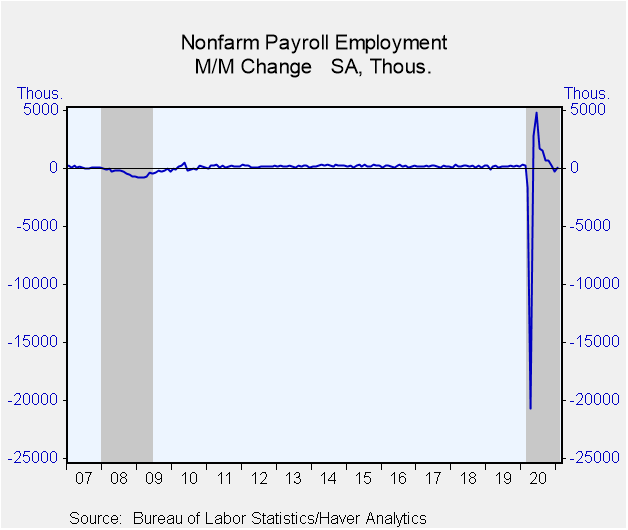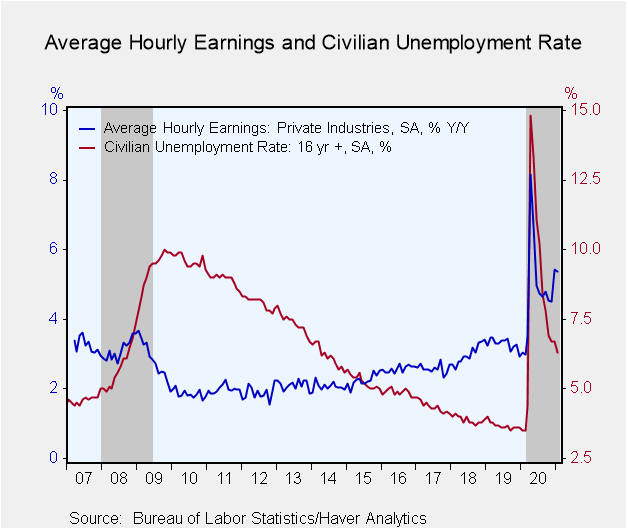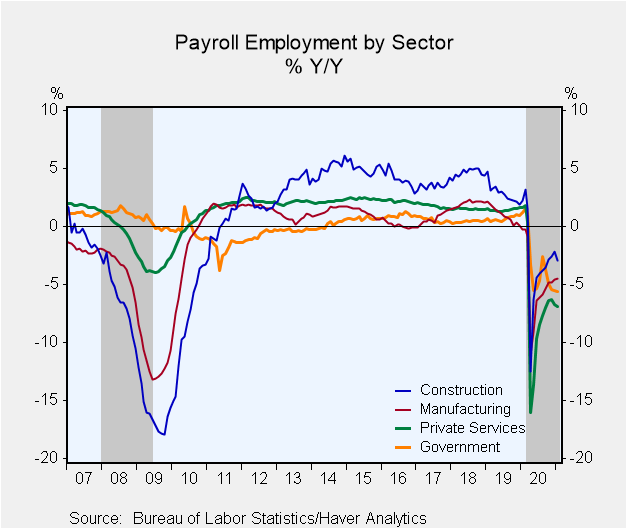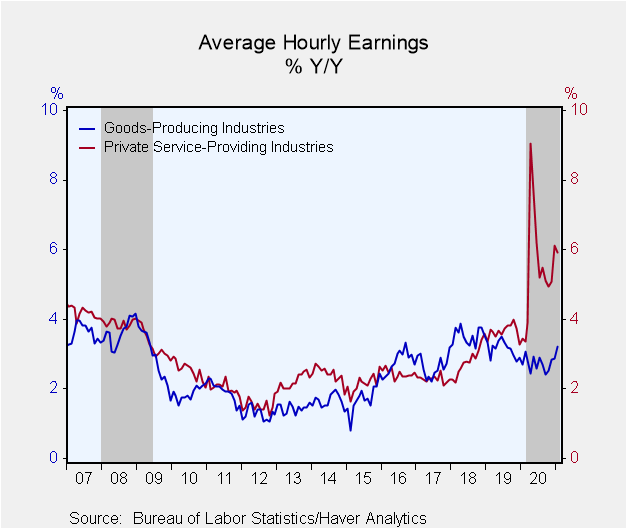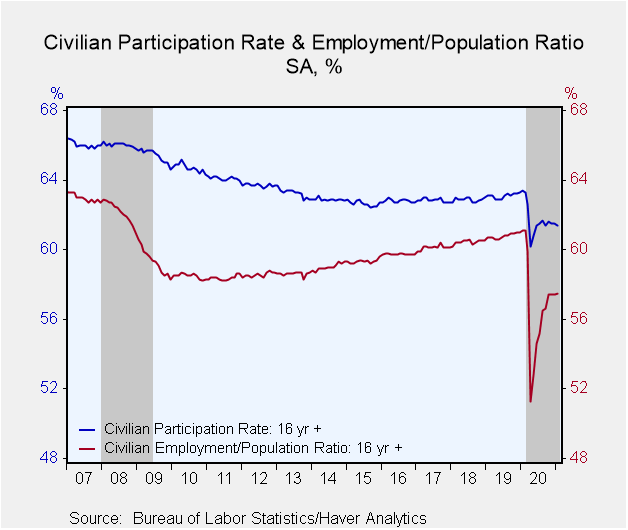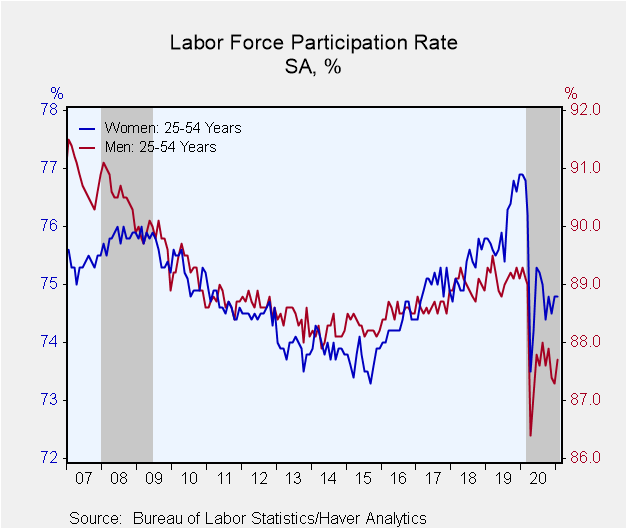 Global| Feb 05 2021
Global| Feb 05 2021U.S. Payrolls Rise Modestly as Expected in January
by:Tom Moeller
|in:Economy in Brief
Summary
• Service sector remains notably weak. • Earnings growth moderates. • Unemployment rate declines sharply to lowest level since March. Weakness in the labor market persists. Nonfarm payroll employment improved just 49,000 during [...]
• Service sector remains notably weak.
• Earnings growth moderates.
• Unemployment rate declines sharply to lowest level since March.
Weakness in the labor market persists. Nonfarm payroll employment improved just 49,000 during January following a 227,000 December decline, revised from -140,000. A 50,000 increase in January had been expected in the Action Economic Forecast Survey. The November employment gain was shaved to 264,000 from 336,000. The estimates of the January payroll change had ranged from 345,000 to -150,000 amongst 25 forecasters.
Average hourly earnings growth moderated to 0.2% (5.4% y/y) last month following a 1.0% December gain, revised from 0.8%. November earnings rose 0.3%. The Action Economics survey had expected a 0.4% January increase.
The unemployment rate declined to 6.3% from 6.7% in each of the prior two months. A rate of 6.7% had been expected. Employment in the household survey rose 201,000 (-5.4% y/y) after increasing 21,000 in December while the labor force declined 406,000 (-2.6% y/y) after increasing 31,000 in December. The overall jobless rate, including those who were marginally attached or working part-time for economic reasons, slipped to 11.1% from 11.7 and reached its lowest point since March.
From the payroll survey, the modest 49,000 rise in jobs reflected a 10,000 January rise in private service sector employment which followed a 280,000 December decline. To the upside, professional & business services employment gained 97,000 (-3.5% y/y) after a 156,000 increase in December while temporary help jobs rose 80,900 (-8.7% y/y) after gaining 64,300 in December. Jobs in the information sector rose 16,000 last month (-7.7% y/y) after a 6,000 gain. Employment in finance rose 8,000 (-0.6% y/y) after improving 18,000 in December. Working lower was employment in trade, transportation & utilities which fell 50,000 (-2.6% y/y) including a 37,800 easing (-2.1% y/y) in retail trade. Leisure & hospitality jobs weakened 61,000 (-22.5% y/y) after falling 536,000 in December. Education & health services employment fell 7,000 (-5.1% y/y) following a 31,000 decline. In the goods producing sector, factory employment fell 10,000 last month following a 31,000 December rise. Construction payrolls fell 3,000 following a 42,000 increase. Mining & logging sector employment improved 9,000 (-10.8% y/y) after rising 3,000.
Government sector employment rebounded 43,000, following four consecutive monthly declines. Local government employment rebounded 36,000 (-6.6% y/y) following three declines in four months. State government jobs rose 31,000 (-6.0% y/y) but have been declining since February 2020. Falling by 24,000 (+0.6% y/y) was federal government employment following declines in three of the prior four months.
The 0.2% rise in average hourly earnings in January reflected a 0.6% decline (+5.1% y/y) in education & health services which came on the heels of an upwardly revised 2.0% surge. A 2.2% advance (8.2% y/y) in retail trade earnings countered that fall. Elsewhere in the service sector, professional & business service earnings rose 0.2% (3.8% y/y) and leisure & hospitality earnings increased 0.5% (2.3% y/y). Factory sector earnings improved a minimal 0.1% (3.0% y/y) while construction sector pay rose 0.2% (2.8% y/y).
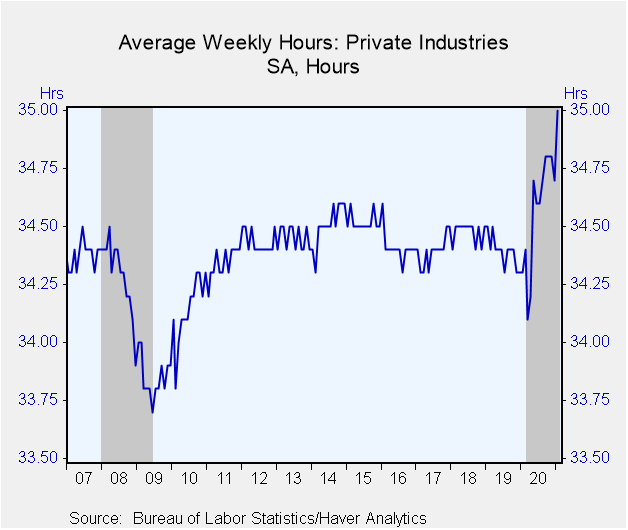 Hours-worked in the private sector lengthened to 35.0
in January from 34.7. Hours for production & nonsupervisory workers
surged to 34.4, their longest workweek since April 2000. Mining &
logging sector hours rose to 45.1 and were up from last year's average of
44.4. Construction sector hours rose m/m to 39.3, the highest since
September 2019. Factory sector hours improved to 40.4 and remained up from
38.0 last April. Overtime hours in the factory sector held steady m/m at
3.2, up from April's 2.1 low.
Hours-worked in the private sector lengthened to 35.0
in January from 34.7. Hours for production & nonsupervisory workers
surged to 34.4, their longest workweek since April 2000. Mining &
logging sector hours rose to 45.1 and were up from last year's average of
44.4. Construction sector hours rose m/m to 39.3, the highest since
September 2019. Factory sector hours improved to 40.4 and remained up from
38.0 last April. Overtime hours in the factory sector held steady m/m at
3.2, up from April's 2.1 low.
Private service sector hours lengthened to 33.9, a record high. (The series dates back to 2006.) Financial sector hours held at 37.8. Information sector hours rose to an elevated 37.1, while professional & business service hours jumped to a record 37.0. Education & health hours rose to a new high of 33.6 while leisure & hospitality rose to 25.8 and have been moving sideways during recent months.
From the household survey, the reduced unemployment rate of 6.3% in January occurred as the labor force participation rate eased to 61.4%. It remained down from 63.4% in January of last year. The teenage participation rate fell to 35.4%. For those aged 20-24, it dropped to a four-month low of 70.2%. For workers aged 25-54, the rate edged up to 81.1% but still was below the January 2020 high of 83.0%. For men aged 25-54, the rate rose to 87.7% but remained down from the high of 89.5% in March of 2019. For women of that age, the rate held steady at 74.8% and remained well below the record high of 76.9% one year ago. For workers aged 55 & over, the participation rate fell to 38.3%, down from 40.3 one year ago.
The employment/population ratio for all workers edged higher to 57.5% in January, up from April's low of 51.3%, but remained well below the October 2019 high of 61.2%. The average duration of unemployment rose to 26.0 weeks, the longest since September 2017.
The teenage unemployment rate eased to 14.8% from 16.0% in December and remained below the record 32.1% last April. The rate for workers aged 20-24 fell sharply from 11.2% to 9.7%, its lowest since March of last year. For workers aged 25-54, the rate held m/m at 5.8%, down from the 12.8% April high. For those over 55, the jobless rate declined to 5.3% and was below the record 13.6% in April.
By educational attainment, the rate of unemployment of workers without a high school diploma fell to 9.1% from 9.8%, remaining well below the 21.0% rate in April. High school graduates without any college were 7.1% unemployed last month, down from April's high of 17.3% but higher than the 3.5% rate in February 2020. Those with some college but no degree were 6.2% unemployed, down sharply from the 15.0% April peak but still up from January 2020's record low of 2.7%. College graduates experienced 4.0% unemployment last month, still significantly higher than their 1.9% low in February of last year.
The employment & earnings data are collected from surveys taken each month during the week containing the 12th of the month. The labor market data are contained in Haver's USECON database. Detailed figures are in the EMPL and LABOR databases. The expectations figures are in the AS1REPNA database.
| Employment (SA, M/M Change, 000s) | Jan | Dec | Nov | Jan Y/Y | 2020 | 2019 | 2018 |
|---|---|---|---|---|---|---|---|
| Payroll Employment | 49 | -227 | 264 | -6.1% | -5.8% | 1.3% | 1.6% |
| Previous Estimate | -- | -140 | 336 | -- | -- | -- | -- |
| Manufacturing | -10 | 31 | 41 | -4.3 | -5.0 | 1.0 | 2.0 |
| Construction | -3 | 42 | 24 | -2.7 | -3.0 | 2.8 | 4.6 |
| Private Service-Producing | 10 | -280 | 291 | -6.6 | -6.6 | 1.4 | 1.5 |
| Government | 43 | -23 | -95 | -5.5 | -3.1 | 0.7 | 0.5 |
| Average Weekly Hours - Private Sector | 35.0 | 34.7 | 34.8 | 34.3 | 34.6 | 34.4 | 34.5 |
| Private Sector Average Hourly Earnings (%) | 0.2 | 1.0 | 0.3 | 5.4 | 4.8 | 3.3 | 3.0 |
| Unemployment Rate (%) | 6.3 | 6.7 | 6.7 | 3.5 | 8.1 | 3.7 | 3.9 |
Tom Moeller
AuthorMore in Author Profile »Prior to joining Haver Analytics in 2000, Mr. Moeller worked as the Economist at Chancellor Capital Management from 1985 to 1999. There, he developed comprehensive economic forecasts and interpreted economic data for equity and fixed income portfolio managers. Also at Chancellor, Mr. Moeller worked as an equity analyst and was responsible for researching and rating companies in the economically sensitive automobile and housing industries for investment in Chancellor’s equity portfolio. Prior to joining Chancellor, Mr. Moeller was an Economist at Citibank from 1979 to 1984. He also analyzed pricing behavior in the metals industry for the Council on Wage and Price Stability in Washington, D.C. In 1999, Mr. Moeller received the award for most accurate forecast from the Forecasters' Club of New York. From 1990 to 1992 he was President of the New York Association for Business Economists. Mr. Moeller earned an M.B.A. in Finance from Fordham University, where he graduated in 1987. He holds a Bachelor of Arts in Economics from George Washington University.


